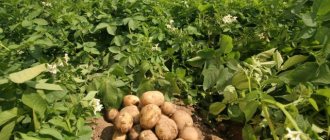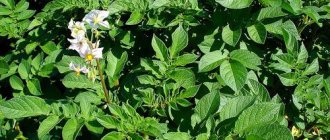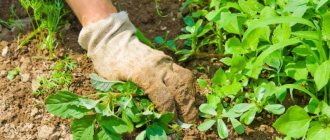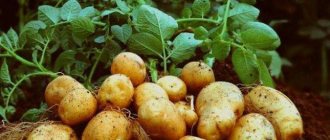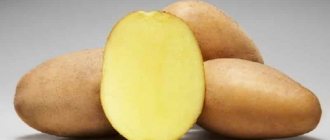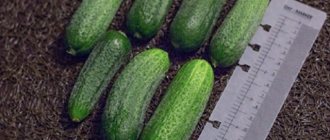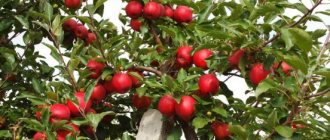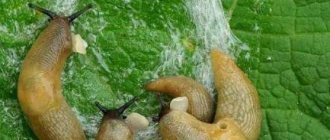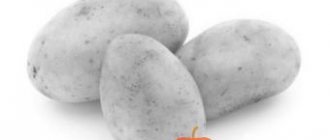Description with photo and characteristics
The variety was bred in Holland in the last century. In the central part and south of the country, the variety has spread so much that it occupies a leading position and has not given up for decades. The variety has a high yield potential: up to 600 centners of potato crop can be harvested per hectare of land.
In terms of external characteristics, Red Scarlet clearly stands out among other potato species. The tuber has a red, slightly rough skin, an oblong shape, and the cut flesh is yellow. A lot of tubers are formed, from 15 to 20 pieces, ripening and growth occur in all potatoes simultaneously, without delay. The potato size is medium. Weight is usually 100g, but can go up to 160g.
The starch content is low, 11-14%. Potatoes do not cook well, the tubers do not lose their shape and appetizing appearance after cooking. It is rarely used for making puree; the tubers are mainly used for cooking soups and baking.
Interesting! Red Scarlet is grown on an industrial scale. Potatoes are then used to make chips and fries.
The potato bush is small and stunted. After planting, the tops form quickly and become thick. The color of the tops is dark green, rich. The stems are small, but powerful and erect.
Potatoes bloom in early summer with light lilac flowers, and begin to sing in mid-summer. The ripening period takes 60-65 days. Productivity depends on weather conditions. If the summer was warm and it rained heavily, then less than 50 tons per hectare will definitely not grow.
Red Scarlet is suitable for growing in any region: potatoes are not afraid of drought and frost, and are not too picky about the soil. The variety has strong immune qualities; diseases and viruses are not afraid of it. It even resists potato cancer and nematode. There are rare cases of infection with Alternaria, late blight and scab.
The positive qualities of the Red Scarlet variety are:
- short period of tuber ripening;
- unpretentiousness in planting and further care;
- universal purpose;
- good taste;
- compact tuber size;
- possibility of cultivation regardless of the region;
- strong immune qualities.
The variety has no obvious disadvantages, so it is still in active demand for planting among gardeners.
Description
The variety is an early variety: the period from germination to technical ripeness is 70-80 days. It is distinguished by intensive and rapid accumulation of the harvest of marketable products already by the 45-55th day of the growing season.
Bushes of medium height, intermediate type, semi-erect with fairly powerful stems, dark green leaves and red-violet flowers
The plant is low or medium-sized, semi-erect. The stems are medium thick with moderate anthocyanin coloring. The leaves are small, dark green, matte, open, slightly wavy at the edges. The inflorescences are medium in size, the flower corollas are red-violet with a faint anthocyanin color on the inside. The light sprout is ovoid in shape with a medium pubescent red-violet base.
The light sprout is ovoid in shape with a medium pubescent base of red-violet color.
Appearance and characteristics of tubers
The tubers have a smooth, very attractive appearance. They have an oblong, elongated oval shape with a diameter to length ratio of 1/1.5-1.69 (shape index), medium or large sizes, weight 60-125 g. The color of the peel, as the name of the variety suggests, is red (from the English. red), pulp – light yellow or yellow. The surface of the tuber is almost smooth, slightly flaky. The eyes are small, lying to a depth of 1.1-1.3 mm.
The tubers are covered with a red skin, have a leveled shape and size that is optimal for mechanical cleaning
According to culinary purposes, the variety belongs to types A-B, that is, universal, the tubers practically do not boil softly (weakly crumbly) and do not change the color of the pulp after cooking. Boiled potatoes "Red Scarlett" in terms of taste characteristics received a tasting score of 7 points (on the 9-point VNIIKH scale).
Potatoes of this variety are suitable for boiling, frying, baking and mashing. Its pulp does not fall apart and does not darken during heat treatment
The pulp is dense and slightly mealy due to a small amount of starch. The dry matter content in tubers is 16.1-18.8%. Contains:
| Nutrients | Content |
| Starch | 10,1-15,6% |
| Reducing sugars | 0,37% |
It should be noted that the tubers are resistant to shock and other mechanical damage, which ensures the preservation of the quality of the harvested crop during transportation, washing and packaging.
The yield of marketable tubers is 82-96% of the total harvest.
Productivity
Yield indicators largely depend on soil, climatic and weather conditions, and agricultural cultivation techniques.
The average number of tubers in a nest is 9-11 pieces
According to the results of field trials conducted over several years, the marketable yield of the Red Scarlett variety per hectare was:
- in Russia - 164-192 quintals (above the standards established at the level of the Udacha and Zhukovsky Ranniy varieties). Due to the intensive filling of root crops, already on the 45th day after germination, the yield of commercial quality products during the first digging reaches 84 c/ha, on the 55th day during the second digging - 108 c/ha (in the Moscow region), and the maximum is about 270 -277 c/ha (obtained in the Smolensk region);
- in Belarus - an average of 456 centners, the maximum result is 725 centners / ha (recorded at the Molodechensk variety testing station in 2004).
The tubers have a high shelf life with an average storage time. They do not tend to germinate within 6 months (dormant period). Safety factor – 98% without loss of presentation and taste properties.
Disease resistance
A strong argument in favor of the Red Scarlett potato, according to reviews from professional vegetable growers, is its inherent immunity or resistance (resistance) to certain pests and a number of dangerous diseases.
| Disease | Degree of stability | Rating (on a 9-point scale) |
| Golden and pale nematodes (Ro1, Ro4) | High | — |
| Potato cancer (D1) | High | — |
| Virus Y (PVYn, PVYntn) | Increased | 7,5 |
| Late blight of tops | Average | 4,5 |
| Late blight of tubers | High | 7 |
| Common scab | Increased | 5,5 |
When Colorado potato beetles appear, supporters of organic farming prefer to mechanically collect adults and large larvae by hand and remove leaves that have oviposition on the underside. This approach is justified only in small areas. Commercial cultivation requires the use of industrial insecticides (Aktara, Karbofos, Killer, Colorado, Prestige, etc.).
Like most potato varieties, Red Scarlett suffers from common scourges: mole cricket and Colorado potato beetle.
The variety is sensitive to metribuzin, which is part of herbicide preparations intended to eliminate annual dicotyledonous and cereal weeds. Signs of wilting may appear on the tops, so such preparations are used before planting or before the emergence of potato shoots, when weeds have already appeared on the soil surface.
When using chemical pesticides to control diseases, weeds and insect pests, it is important to take all recommended precautions and strictly follow application instructions.
Planting material
Many gardeners prepare seed potatoes themselves, but when grown for more than 5 years, the varietal characteristics degenerate. Therefore, it is recommended to regularly update planting material by purchasing it from reputable manufacturers.
The photo shows planting material for the Red Scarlett potato variety from various manufacturers.
When purchasing seed potatoes, you need to pay attention to the size and condition of the tubers, and also take into account the technology for their production. Planting material of the 1st year is mini-tubers grown from seeds, possessing all varietal characteristics and absolutely healthy. Then:
- in the 2nd year - having planted mini-tubers, when digging up, they obtain planting material of the “super super elite” class;
- in the 3rd year - simply “super elite”;
- in the 4th year - “elite”;
- in the 5th year - the first reproduction of the elite, which may already be infected with various diseases and requires updating of planting material.
Ural Garden specialists talk about the preparation and quality of seed potatoes in the following video:
Features of cultivation
The variety has increased drought resistance, but at high temperatures (30-40 ℃), especially on light soils, dark spots may form in the tuber pulp. To avoid this, it is necessary to form larger ridges, provide regular watering and add additional doses of fertilizers containing calcium to the soil.
The recommended planting depth is average; for uniform germination and uniform germination, it is necessary to adhere to the same depth of seed tubers throughout the entire area
"Red Scarlett" responds well to nitrogen fertilizing in quantities usual for early varieties, as well as to additional application of magnesium and manganese. When planting, the tubers are placed at an average depth (up to 10 cm). It is recommended to make distances of 70-75 cm between the ridges, and between plants:
| Size of planting tubers, cm | Distance between holes, cm |
| 2,8-3,5 | 27 |
| 3,5-5,0 | 32 |
| 5,0-5,5 | 38 |
The following are considered important agrotechnical requirements for obtaining good results:
- moderate humidity and regular loosening of the soil;
- preventive treatment of plants against diseases, pests and weeds;
- hilling;
- pruning the tops 7-12 days before harvesting the main harvest;
- alternation when planting potatoes and legumes.
Thanks to the combination of high yield, marketability and excellent taste, Red Scarlet, according to reviews from gardeners, is one of the most popular potato varieties on the domestic market.
Landing Features
Potato tubers are planted in the first half of May or in the middle of the month. The ground should warm up a little before planting, otherwise the potatoes may freeze. Be sure to germinate potato tubers before planting so that their eyes awaken after winter. When the sprouts are 2-5 mm in size, the potatoes are ready for planting.
Since Scarlet grows with moderate formation of tops, the distance between holes can be approximately 15-20 cm. The depth of the hole is approximately 25-35 cm. In each hole you need to put 1/3 cup of stove ash and one tuber. The tuber sprouts must be directed downward so that they grow into the ground. The potato field should not be crushed after planting; the soil should remain loose. If possible, if the field area is small, you can water it.
Growing rules
To grow a good harvest it is not necessary to spend a lot of effort and energy. Red Scarlet is a rather unpretentious variety and anyone can grow this crop. But at the same time, do not forget about the classical rules of growing.
Seed potatoes are selected in the fall, in a separate container during sorting. Only healthy tubers without visible defects (growths, cracks, etc.) are selected.
Red Scarlet is an early ripening variety, so there is no need to rush with planting. In any case, you need to wait until the soil warms up to +8-10 C to a depth of at least 10 cm. You can navigate by the birches. If the buds have begun to bloom on this tree, then you can safely start planting potatoes.
Planting patterns are standard, either 60x35, 60x40, or 70x35, 70x40. The maximum planting depth is 10 cm. However, it is not recommended to plant tubers so deep; the ideal is 5-7 cm.
We recommend reading: “Description of the Mayak potato variety”
Typically, the first shoots appear 2-3 weeks after planting, even if the seed material has not been germinated beforehand.
To get the maximum amount of products, you must follow a number of the following rules:
- Plant the crop only in well-lit areas with high-quality natural aeration.
- Regularly loosen the soil after rains and waterings.
- Hill up the bushes twice a season.
- Clear the area of weeds.
- Water the potatoes three times a season.
- In the fall, dig up and fertilize the garden.
Features of care
Red Scarlet sprouts quite quickly; within a couple of weeks, green tops will appear above the ground. You need to wait until the tops sprout a little, then the soil needs to be loosened and weeded. The formation of young tubers is influenced by weeds and foreign grass. Plants take nutrients from the soil, so they need to be pulled out immediately as soon as they sprouted. Loosening the soil is necessary for potatoes to grow.
If the soil is fertile and porous, then no fertilizing is necessary for yield. If you plant potatoes in clay soil with a low organic content, you can scatter ash mixed with sand over the area. Scarlet responds well to watering with potassium permanganate. To do this, you need to dilute a weak solution of potassium permanganate so that its color is pink. Water the ground with the solution, you can irrigate the leaves with it. In addition to nutrition, potassium permanganate has antibacterial properties and prevents the development of bacteria and viruses.
Attention! Fertilizing with potassium permanganate is carried out before the potato tops begin to flower.
Characteristic
Those who like soggy potatoes won't like Red Scarlet. This is a dense fruit that retains its elasticity even after long cooking. Potatoes have a normal taste. No sweetness. To a greater extent, this type of potato is recommended for frying or making French fries. Also great for salads, as it is easy to cut (it doesn't crumble). But it is also suitable for consumption boiled.
As mentioned above, the fruit is excellent for sale. It has a long shelf life and almost all fruits (96%) are suitable for sale after digging.
It is worth noting that Red Scarlet potato tubers are resistant to one of the main fruit pests - potato nematode. In the fields where this fruit is grown, it is extremely rare.
Harvesting and preparation for storage
The first fruits of Scarlet can be enjoyed in the middle or end of July. Potatoes are fully ripened by the end of summer. You need to dig up the tubers in dry weather so that the ground is not wet. Potato tops can be used as fertilizer for the next year.
The dug up crop is cleared of soil and dried well in a warm, dry place. When the tubers become dry, they are sorted. Seed potatoes are set aside separately - those that will be needed for planting next year. The tubers are sorted into bags and lowered into the cellar or basement. In the harvest storage room, the temperature should not rise above 10 degrees Celsius, otherwise the potatoes will begin to sprout.
Advantages and disadvantages. Taste qualities
Advantages of the Scarlet variety:
- Unpretentiousness in cultivation;
- It has a short period of complete vegetation, from 65 to 70 days;
- High tolerance to nematodes;
- High yield;
- Excellent taste;
- Retains color during cooking and is not overcooked;
- Tolerates dry periods well;
- Well transported;
- Retains its presentation for a long time and does not darken from mechanical damage;
- Can be stored for a long time.
According to reviews from gardeners, this variety has no disadvantages.
TOP5 - ultra early potato varieties:
Reviews from those who planted Red Scarlet potatoes
Andrey, Vitebsk
This variety has been grown for more than three years. Always reaped high yields. I like that the plants grow quickly and are able to effectively suppress weeds. With timely watering and weeding, I collect up to 15 kg. large tubers from 1 m2. The taste is excellent. The harvested crop is well stored.
Anna Magnitogorsk
An excellent variety with a whole range of positive characteristics, the main ones being high productivity and resistance to dangerous fungal diseases. The tubers are very tasty and can be stored for a long time.
Sergey, Pikalevo
I only grew this variety for a year, but I realized that this is what I had been looking for for so long. The tubers are tasty, large and easy to clean. Plants develop quickly and can grow successfully in a variety of soils. And most importantly, I reaped a good harvest.
Reviews about the variety
Agronomists especially value the Scarlet variety for its advantages: excellent taste, marketable appearance, long shelf life, excellent yield. In addition, this variety has gained great popularity in catering establishments due to its excellent taste.
Scarlet potatoes are extremely popular because they have a high content of vitamins, minerals and amino acids, as well as excellent taste that lasts for a long time.
The most productive potato varieties:
Diseases and pests
What are the features of Scarlet potatoes? A description of the variety, photos, and reviews were presented in the article, but the issue that is of particular concern to many vegetable growers has not yet been addressed. Almost all crops suffer from diseases and pests, and Scarlet is no exception. The variety is resistant to viral diseases:
- golden nematode;
- cancer;
- late blight
Although late blight sometimes occurs, it most often appears on the tops, but the tubers remain safe. Particular attention should be paid to bushes when the outside temperature is high with high humidity. This is the ideal weather for the development of this disease.
Treatment of tubers before planting is considered a good prevention of late blight. Copper sulfate or boric acid has been used for this for many years. These remedies are very effective in this matter.
Rarely, but such a disease as scab also occurs. In more detail, scab is a fungal disease that affects tubers. This disease also often occurs in high temperatures and humidity. It is impossible to completely eliminate scab from the soil. It is recommended to periodically change the location where potatoes are planted. In general, scab cells live in the soil for about five years. But they begin to lose their strength after two years. This is exactly the time when it is worth starting the fight using special chemicals.
Unfortunately, the variety is not insured against Colorado potato beetles and mole crickets. No potato variety can escape these pests. To combat it, you can use the traditional collection of beetles and destruction, or you can purchase chemicals in a specialized store, the action of which is aimed specifically at combating these pests.
There is an effective folk method of fighting mole crickets. To do this you will need a vinegar solution. If a gardener finds a mole cricket burrow, he pours this solution into it. The insect simply has no chance of surviving.
If you follow all the recommendations regarding pest and disease control, the harvest will be good and healthy, and the owner will be provided with potatoes for the whole winter.
